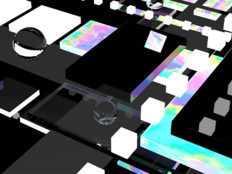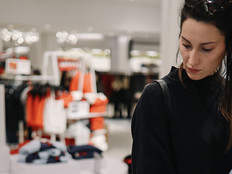Is the Future of Screen Technology in Our Minds? Mary Lou Jepsen Thinks So
There have been monumental advances in screen technology in the past decade. We’ve shrunk screens down to pocket-size while packing more pixels into mobile devices such as smartphones. Apple’s Retina display, rolled out in its iPhone and iPad products, is the most recent example of how far high-definition displays have come for mobile devices.
But what if the future screen is not one that you hold in your hand, but rather one that you render straight from your eyes?
Mental-imaging technology is still in its infancy, but Mary Lou Jepsen, CEO of Pixel Qi and former chief technology officer of One Laptop per Child, believes that advanced mental-imaging technology of the eye is achievable within the next 10 years.
Jepsen spoke at length about mental-imaging technology at a Google Solve for X forum back in February. For Jepsen, the next step in advancing this technology is “pulling the image right off the retina, as if the movie screen is the retina. And there's a lot of data that shows this is possible,” she said.
We recently spoke with Mary Lou Jepsen about her experience as a woman in technology and about what the future holds for screens.
BIZTECH: You've received numerous awards and accolades for your work on the One Laptop per Child initiative. Are there any in particular that you're most proud of?
JEPSEN: By far the biggest award is getting laptops to kids to transform their opportunities in the world. I’m deeply honored that so many organizations have honored me or the work of OLPC in the process — it’s really great support for the mission of the organization and the people who make it tick.
BIZTECH: What were some of the highlights from your time spent working on OLPC?
JEPSEN: I’d say 2005 was one of the most spectacular years I’ve ever lived.
In winter 2005, after a tough year as a group CTO at Intel, I met with Nicholas Negroponte and realized that I could join with him and architect the $100 laptop. That spring, the president of Brazil changed his travel schedule to meet with us in Brazil — OLPC was only two people then — and announced that Brazil would be the first country to adopt the OLPC program en masse.
In the summer, U.N. Secretary-General, Kofi Annan asked me to unveil my prototype at the U.N. World Summit on The Digital Divide in Tunisia. I slept every other day for months to meet the tough schedule, but the unveiling was a huge hit.
By fall 2005, over half of the heads of state on earth had expressed strong interest in buying laptops from OLPC en masse to transform the educational opportunities for their children. We convinced the largest manufacturers of the world to take my design and move it into mass production.
BIZTECH: Would you say it's become easier for women to make an impact in the technology industry, as you've done, or is it still an uphill battle?
JEPSEN: In terms of women in technology, the numbers are still low, and by many counts getting lower. I hope that OLPC makes an impact on this in the developing world.
BIZTECH: What motivates you to tackle the challenge of producing green displays?
JEPSEN: We are moving to a world with more screens everywhere — in devices, and on tables, walls and surfaces of all kinds.
We need to lower the power consumption of screens to enable this future, or the walls and the tables will be too hot and too hard to install, cable and drive, and we won’t be able to switch back to quiet, normal-looking walls on command.
Further, devices should not need power adapters. The calculator is, I believe, the correct model. A little room light on a solar cell is all that is needed to power a calculator.
Wouldn’t it be great if we could do the same for cell phones, laptops, tablets, personal medical devices and so on? To get there, we will use better solar cells and batteries, but the screens must decrease the power consumption a hundredfold to enable this, as we are doing at Pixel Qi.
BIZTECH: What advances has Pixel Qi made so far in display technology?
JEPSEN: We have pushed the power consumption of screens down by up to 10 times in products we have shipping today and are poised to bring that down another 10 times using our new architectures. We have shipped 3 million units, all sunlight-readable in direct sunlight, and are the first truly fabless display company using existing high-volume machinery at the factories in novel ways to achieve this dramatic power savings.
BIZTECH: Many of the startup companies getting the most attention are software-based. As a hardware technologist, what inspires you to continue improving and innovating in hardware?
JEPSEN: Thanks for noticing. Hardware has become a cheap commodity in Asia, but we can use the same equipment and manufacturing facilities to make really great, innovative and green things. No one is working like Pixel Qi is on this, and I felt that I had an obligation, because I got my foot in the door with the work that I did with OLPC, to keep going. The whole world needs better, greener devices, especially as we look at the projected 50 billion devices that will ship per year, come 2020.
Someone needs to do this to get to an interesting future — it can’t all be iPhone apps. The world’s information is digital, and the way we access it is through the screen. The screen is really a bottleneck: It limits what you can see, it’s the most expensive component in any device, and it’s by far the biggest power hog.
BIZTECH: Has your company had a chance to work with Intel's Medfield chip? Does it impress you in terms of power consumption?
JEPSEN: Intel, and companies like it, will respin a chip to save 10 milliwatts. Our screen technology in a tablet can save more than 5 watts. That’s 50 times the savings. In a new iPad — the third version — it appears that the screen can use over 90 percent of the battery. The battery is there essentially to power the screen. It’s not about the CPU anymore. The future of mobile computing is all about the screen.
BIZTECH: What's one crazy technology idea you believe in that others aren't yet convinced of?
JEPSEN: I believe that we are very close to being able to see the mental images and dreams of others. I gave a talk on this recently at a Google event and believe that I know how to dramatically move this forward in the next few years — but at the moment, I consumed with running my start-up, Pixel Qi — so I’m figuring out a way to pursue this in the near future.







